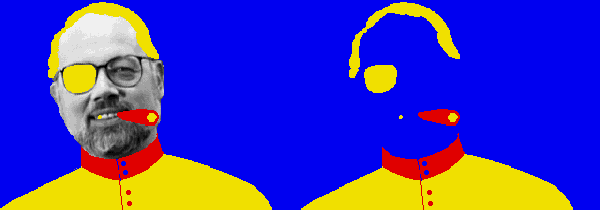

Words don't have as much power over me as they should.
Perhaps this is why I can no longer read novels. The words fail to take hold of me, fail to transport me to the place where the story is.
I read a lot of non-fiction. But in my own way. I tend to skip the preliminaries, the parts where language wants to set you up, so you'll see things ITS way. I always want to cut to the chase, to the heart of the matter, to where the ideas are. (I know, I know, ideas are out, words are in -- but words don't have as much power over me as they should). So I skip around a lot. Eventually, as I leaf through the book, I usually realize I've read the whole thing. But in my own way.
Perhaps this is why I can no longer read novels. A novel wants to set you up, so you'll see things ITS way. If you try to cut to the chase, to the heart of the matter, the novel will not work. The novel wants to be like a piece of music. So even though you could skip around, it doesn't want you to. It wants to flow like music. I love music. But I cannot accept that words should flow like music. If I CAN skip around but I'm not SUPPOSED to, I feel like I'm being controlled. But words don't have as much power over me as they should. Perhaps this is why I can no longer read novels.
This is a picture of me with my alter ego:

I call it: Two Spiffs
But I'm not really a "spiffy" type, if you know what I mean. So this image must come from some deeply repressed core of my unconscious.
A lot of things I make and do seem to come from that place. For example, you might want to take a look at the following, my Book of the Year Three Thousand.
Here's another poem of mine, published a few years back in the Mississippi Review, entitled Scratch.
You might get a kick out of a few other strange "self"-portraits: The Invisible Man--Two Musicians--Displaced Person 1--Displaced Person 2--Facemask 4--Facemask 5. These were done strictly for fun, by the way. I am NOT a graphics artist.
And my sister wanted me to tell her a story.
Here's the link to one of my most ambitious projects, centered on a play with music called I Bertolt Brecht.
An idea that has been very important to me for many years, both as artist and theoretician, is what I call "negative syntax" or "antax," a new way of thinking about certain aspects of art, expression and communication. Among other things, this theory involves a re-consideration of what modernism is/was all about. This is the principal theme of my essay Modernism/ Postmodernism/ Neomodernism.
The theory of negative syntax first came to me while I was writing a book dealing with certain aspects of film theory that I found puzzling. Finally, after many years, I've managed to make this book, which never quite got published, available on the Internet. Here it is: Montage, Realism and the Act of Vision.
The essentials of my idea are outlined in a paper, published in 1993 in the journal Semiotica, entitled "Toward a Unified Theory of the Arts." Don't be misled by the title. What is "unified" in my theory is unified only to the degree that it is also disunified. (If this makes no sense, you need to read more Derrida.) This paper was reissued in the internet journal, Music Theory Online, with a preface and an additional "postscript," dealing mostly with the musical aspects. You can access it here: Toward a Unified Theory of the Arts.
Another essay, on Mondrian, is intimately related to my theory. Here it is, as published in the journal Art Criticism: Mondrian and the Dialectic of Essence.
In my opinion, some of the most fundamental properties of negative syntax can be found in the Cubism of Picasso and Braque. My paper Passage from Realism to Cubism:The Subversion of Pictorial Semiosis (also published in Art Criticism) deals with this relationship and in so doing raises many issues that are important for an understanding of my theory.
Probably the most important influence on my thinking regarding negative syntax are the films and writings of Stan Brakhage. An essay of mine dealing with his work has recently appeared in the Millennium Film Journal, issue 32/33, Fall 1998: Brakhage and the Theory of Montage. My title was deliberately based on that of a famous essay by Ezra Pound, "Antheil and the Theory of Harmony." Since Pound is one of Brakhage's favorite poets, I think this title is appropriate (if more than a little presumptuous -- ahem).
Some very intense thought and a good amount of careful scholarship over a period of many years have gone into my work on "negative syntax." But the following essay, on the relation between the 20th century German philosopher Heidegger and the ancient Greek philosopher Heraclitus, was written pretty much off the top of my head, as a letter to my ex-student and friend, Dave Lee, who has an interest in ancient Greek philosophy. Some who are much more knowledgeable about Heidegger than I, have taken offense at this piece, but I rather like it. It's called The Obscure.
My unconscious must have been at work when I wrote this as well, since I have been interested for many years in "obscurity." I love to create works of art that take place in complete darkness. When my films are shown, I have a terrible time with the EXIT signs, which neutralize the intense darkness the films require.
My computer video piece "Hommage to Fernand Leger" should also be seen in a totally darkened space. It's a DOS program (for PC only) which you may download and run.
Recently I've completed two more computer video works, which may now be downloaded from this page. Both are in Windows format and should be compatible with Windows 3.1, 95 and 98 (be sure to read the "readme" files, however).
Alegrias is a good example of "negative syntax," since it is highly disjunctive, with all the structural "weight" placed on relatively ephemeral elements and localized relationships. There is a strong emphasis on what I call "negative time," which resists temporal flow, to the point that time becomes highly staticized, continually stopping and starting over, with no clear distinction between temporal "figure" and "ground."
To Stone also employs negative syntax, but much less "purely," as it is far more complex. Unlike "Alegrias," which is basically an algorithmic work, with no clear beginning or ending, "To Stone" does have an overall structure, lasting about 25 minutes. Each time you run it, however, most of the details will be different.
Yes, I too have a crackpot theory, a good one, about "the universe and everything." I call it Tiny Alice.
And I have written exactly one piece of science fiction, a truly disturbing tale inspired by an episode of Star Trek the Next Generation. Actually it's metaphysics disguised as science fiction: The Transporter Dilemma.
If you have any questions, or would just like to say "Hello," please Email me